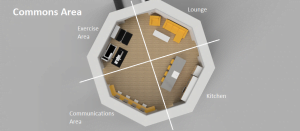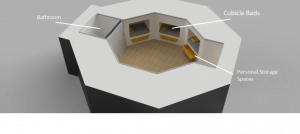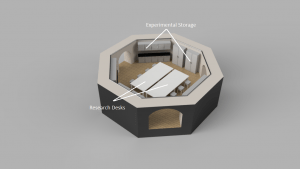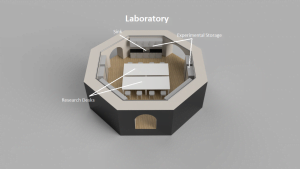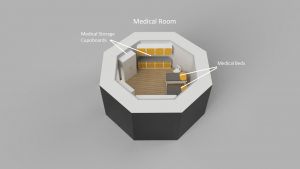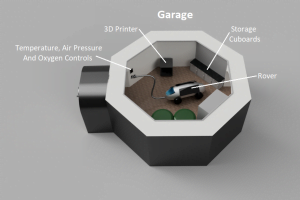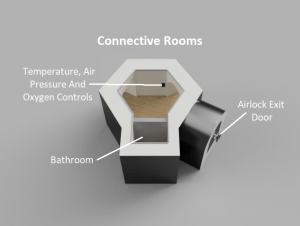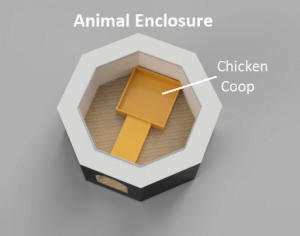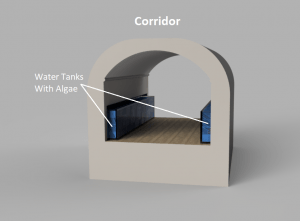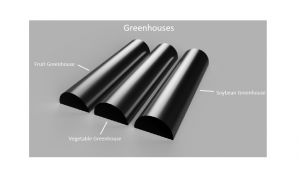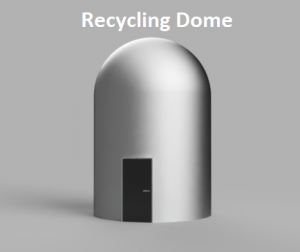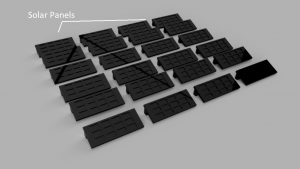Moon Camp Pioneers Gallery 2020-2021
In Moon Camp Pioneers each team’s mission is to 3D design a complete Moon Camp using Fusion 360. They also have to explain how they will use local resources, protect astronauts from the dangerous of space and describe the living and working facilities.
Team: Serenity
Loreto Secondary School Balbriggan Ireland 15, 16, 17
External viewer for 3d project
|
Project description
Our moon camp is a fully functioning living space for astronauts where they can carry out their scientific research and day to day activities. It is comprised of 9 rooms including the commons area, bedroom, two bathrooms, three greenhouses, garage, animal enclosure, laboratory and medical room. In the commons area we have an exercise area to avoid muscle decomposition, lounge, kitchen and computer area to report research findings. Our bedroom is where the inhabitants will sleep and store personal items. In the greenhouse plants are grown for food. The garage is used for storage e.g. our rover used to collect soil samples for inspection and research. We also have a 3D printer used to make parts for the camp if anything breaks. The laboratory is where all the research and testing takes place. We have the medical room that is used if anybody gets ill or injured. We have created the wing so it can be isolated from the rest of the camp if any person contracts contagious or unknown diseases. All of the exit doors have airlock seals so if the camp is compromised, it is isolated from the outside. We have developed a free standing waste recycling system based on the system on the Apollo missions that would burn waste to ash which can be used as fertiliser for plants. Finally the elevator will bring the rover and inhabitants to the surface to get solar cells and soil samples as our camp will be in a lavatube. |
|||
|
Where do you want to build your Moon Camp?
We decided to build our moon camp near the northern rim of the Peary crater due to its near-constant illumination which would provide a nearly uninterrupted solar power supply and relatively stable temperatures. It is also near permanently shadowed areas that may contain frozen water. Our camp will also be located at the bottom of a lava tube in order to protect the inhabitants from harmful radiation, asteroids, meteorites and other debris. It will still be fully functional underground as we have built an elevator which can bring the rover and inhabitants up to the surface of the moon for tasks such as collecting solar cells and obtaining soil samples from the surface. How do you plan to build your Moon Camp? Describe the techniques and materials you would use.
Our main aim when building the moon camp is that it is a suitable environment for astronauts to stay in for a long time, each area is thoroughly thought out to make the most of the space and be fully functional. Covering the moon camp is a layer of lunar soil to protect inhabitants from radiation.The rooms are octagonal in shape which allows all parts of the camp to be connected and feel more open. As our camp is underground it’s important that it feels spacious otherwise astronauts may feel claustrophobic. The exits have airlock doors and the walls are 1.5m thick with insulation to ensure that oxygen and heat stay in the camp and air pressure doesn’t change. The floors are raised to allow for electricity, heat and water piping underneath. Basic materials in the moon camp such as tools will be made using a 3D printer in the camp while the larger materials used to build the camp will be brought from Earth. Bringing large parts from Earth will be difficult and time consuming so we kept the camp smaller in size. The main interior colours were canary yellow and light grey. It was important to use colours in the camp such as yellow as they are uplifting. It won’t be easy for astronauts’ mental health to be away from family and friends for long lengths of time in the dark lava tube therefore the camp needs to be bright, not dark or gloomy. The environment on the Moon is very dangerous for the astronauts. Explain how your Moon Camp will protect them.
By building our camp at the bottom of a lava tube, the astronauts are going to be protected from harmful radiation, asteroids, meteorites and other debris. We have airlock doors at the exits in the garage, commons area and greenhouses to prevent the loss of oxygen and a change in heat or air pressure. We also have three screens which monitor temperature, air pressure and oxygen levels that are beside the airlock doors. Another way we are keeping them safe is by having a separate medical room in case any astronauts develop contagious diseases, they can be confined there. We have a 3D printer to help our astronauts if anything ever breaks for example a part of the rover or airlock door. Finally, we have built an exercise space in the commons area to combat the depletion of muscles due to there being less gravity. Explain how your Moon Camp will provide the astronauts with:
|
|||
|
Water
|
Food
|
Electricity
|
Air
|
|
When deciding on our water system, we looked at many different systems. We chose to base ours off the water recycling system on the ISS. Water vapor will be extracted from each room and fed into the filtration system through pipes that go around the ceiling of each room. At the beginning we will bring water from Earth however, in the long term 99% of our water will be recycled. Once the camp is fully running, we will drill for ice to make up for the lost 1% and put it through our thawing machine. |
We have developed a system where basic vegetables, fruits and soya beans will grow in our greenhouses for food using vertical farming. We will use artificial light to help with this process. Inhabitants will also eat the excess algae as it’s constantly reproducing. The algae is high in vitamins A,C and K, minerals, calcium, iron and magnesium, so it’s nutritious! We will also have eggs from our chickens for protein. Army style meals and snacks will also be brought from Earth as they have an extremely long shelf life and will help provide other essential nutrients to the inhabitants. |
We chose to use solar panels as our source of energy for the moon camp. We strategically located it at the northern rim of the Peary crater where there is continuous sunlight, except when there is a lunar eclipse which on average happens twice a year. The solar panels convert sunlight into electricity and store this in batteries connected to them. We collect the batteries using our rover and bring them back to our base. This is the most efficient way of getting electricity as the batteries are reusable so they are ideal for our camp. |
As a team, we wanted to use a renewable source to produce oxygen and decided that we would use algae and crops that we grow for food for oxygen. We found out that we only need five square meters of algae to produce enough oxygen for one person, so coupled with the plants we will have more than enough. All of our corridors have water tanks for the algae lining both sides of the walls. We have airlock exit doors to keep the air in and circulating throughout the camp. We also have an emergency oxygen supply incase of leaks. |
|
Explain what would be the main purpose of your Moon Camp (for example: commercial, scientific, and/or tourist purposes).
Our moon camp will be used primarily for scientific research. Our rover will be used to collect soil samples from the surface of the moon. These samples will then be analysed in our lab to look for any micro-organisms or water droplets that may be in them and also to complete tests on it. We would also carry out experiments to see which places would be viable to build other Moon camps. In our garage we also have a 3D printer which can be used to make different tools and print parts if anything breaks. We have also made the decision to make use of lunar soil by making some filament out of it so it is more naturally resourceful. We plan to use this filament for tools, however we would not use it for hardy components because it is not as strong as different filaments we could use. |
|||
|
Describe a day on the Moon for your Moon Camp astronaut crew.
The day begins with breakfast in the commons room along with some socialising between all the inhabitants. After breakfast they will then split up to do their different tasks for the day. These tasks include taking the rover up in the elevator and going to collect both solar cells from the solar panels as well as collecting soil samples from the surface to be examined and tested. They will then have lunch in the middle of the day consisting of a mix of the food grown and also the eggs from our chickens. Then they will move onto completing more jobs including being in the laboratory and testing soil samples from the rover for water etc, communicating with earth and checking on the life support systems and the water system. There will be a sleep rotation in place so that there will always be one person awake if anything goes wrong with the life support systems overnight, they can raise the alarm. The inhabitants will then have their dinner, which would consist of a military style meal along with greens grown in the greenhouse and also some of the algae that would otherwise be going to waste. This dinner would provide them with the nutrients they would need to be happy and healthy. Some other jobs they may need to do include repairing the rover and other necessities using the 3D printer if needed, collecting any plants ready to be picked and checking on other plants in the greenhouse. They will also need to exercise during the day for an hour so that their muscles do not deteriorate. This is as they deteriorate faster on the moon than they do on earth. We have made a treadmill, weight lifting machine and an exercise bike that they can use for exercise. To help obtain good mental wellbeing amongst the inhabitants, there will be evenings of fun and games on a Friday and Saturday! These will help them become closer as well as giving the inhabitants something fun to look forward to after a week of hard work. The normal day changes on a Sunday, as this is a rest day for them and if anybody is religious, they can spend this day worshipping or any other practices. The day concludes when most of the inhabitants go off to bed in the sleeping area after a full day’s work. |
|||




